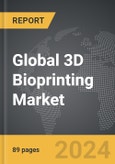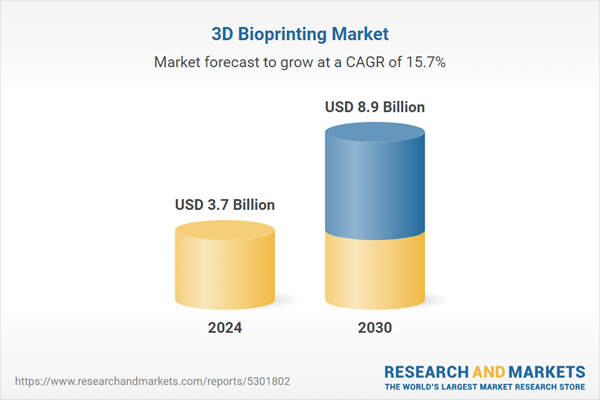Global 3D Bioprinting Market - Key Trends and Drivers Summarized
What Is 3D Bioprinting and How Does It Work?
3D bioprinting is a groundbreaking technology that combines the principles of 3D printing with biological sciences to create functional tissues and organs. The process involves the layer-by-layer deposition of bio-inks, which are substances composed of living cells and biocompatible materials, to build structures that replicate the biological complexity of human tissues. The first step in 3D bioprinting is the digital design phase, where a model of the tissue or organ is created using specialized software. This digital blueprint guides the printer in placing bio-inks with extreme precision. The bio-inks themselves are carefully formulated to mimic the natural environment of human cells, promoting their growth and development. After printing, the constructed tissue is cultivated in a controlled environment to allow for cellular maturation and organization, sometimes supported by scaffolding materials. The potential applications of 3D bioprinting are vast, ranging from the production of skin grafts and cartilage to more complex organs like the liver and kidneys. As bioprinting technology evolves, it promises to overcome many of the limitations faced by traditional tissue engineering and organ transplantation methods.How Is 3D Bioprinting Transforming Medicine and Healthcare?
The transformative impact of 3D bioprinting on medicine and healthcare is already becoming evident, with the technology offering revolutionary solutions in several key areas. One of the most significant applications is in organ transplantation, where bioprinting holds the promise of solving the chronic shortage of donor organs. Researchers are making strides in printing functional, patient-specific organs, such as kidneys, hearts, and lungs, which could drastically reduce waiting times and lower the risk of organ rejection, as the printed organs can be made from the recipient's own cells. Beyond transplantation, 3D bioprinting is enhancing the field of regenerative medicine by enabling the creation of personalized tissue implants, such as skin for burn victims or cartilage for joint repair, that can accelerate recovery and improve patient outcomes. This technology is also having a profound effect on drug testing and development. Traditionally, pharmaceutical companies have relied on animal models for preclinical testing, but these models do not always accurately predict human responses. Bioprinted human tissues offer a more reliable platform for drug testing, allowing for better screening of potential treatments and a reduction in costly late-stage failures in drug development pipelines. As the technology advances, the potential for creating fully functional organs and personalized medical treatments will continue to grow, reshaping the healthcare landscape.What Are the Challenges and Ethical Considerations in 3D Bioprinting?
Despite its promising applications, 3D bioprinting faces several technical, ethical, and regulatory challenges that need to be addressed for it to reach its full potential. One of the primary technical hurdles is the complexity of printing functional tissues that can survive and integrate into the human body. While simpler tissues like skin or cartilage have been successfully bioprinted, more complex organs such as the liver or heart pose significant challenges. These organs require intricate vascular networks to ensure a sufficient blood supply to all areas, and replicating such complex structures remains a major challenge. Moreover, the development of bio-inks that can accurately replicate the diverse mechanical and biological properties of human tissues is an ongoing area of research. Ethically, the ability to print human tissues raises a host of concerns. The potential for creating fully functional human organs could lead to debates over human cloning or the commodification of human tissues. Additionally, there is concern about the equitable distribution of this technology, as it may initially be prohibitively expensive and accessible only to those with the financial means, further exacerbating healthcare inequalities. On the regulatory side, governing bodies are still adapting to the unique challenges posed by bioprinting. Unlike traditional medical devices or pharmaceuticals, bioprinted tissues and organs straddle the line between biological products and synthetic materials, raising questions about how to ensure their safety and efficacy before they can be widely used in clinical settings. Addressing these challenges will be crucial to the widespread adoption and ethical use of 3D bioprinting technology.What Are the Drivers Behind the Growth of the 3D Bioprinting Market?
The growth in the 3D bioprinting market is driven by several factors, all of which highlight the increasing demand for this revolutionary technology across multiple industries. Technological advancements are playing a critical role in the expansion of the market. Innovations in bioprinting equipment, such as higher resolution printers capable of more intricate designs, and advancements in bio-ink formulations that better mimic human tissues, are continuously pushing the boundaries of what can be achieved. These improvements have opened new possibilities in medical applications, attracting investment from both the public and private sectors. Pharmaceutical companies are also major drivers of growth, using bioprinting to accelerate drug discovery and testing processes. The technology offers a more reliable and cost-effective alternative to traditional methods, which often rely on animal testing that may not translate well to human biology. Additionally, the rise in chronic diseases and conditions associated with aging populations, such as heart disease and liver failure, is driving demand for regenerative medicine solutions, where 3D bioprinting offers patient-specific treatments that can improve outcomes. Another significant factor is the growing consumer preference for personalized medicine. Patients and healthcare providers are increasingly seeking treatments that are tailored to individual genetic profiles, and bioprinting offers the possibility of creating tissues and organs customized to each patient's unique needs. Finally, the influx of government funding and partnerships with academic institutions has spurred research and development in the field, further accelerating innovation and the commercialization of bioprinting technologies. These trends indicate that 3D bioprinting is poised to become an integral part of the future of healthcare, with wide-ranging applications from organ transplantation to drug development.Report Scope
The report analyzes the 3D Bioprinting market, presented in terms of market value (US$ Thousand). The analysis covers the key segments and geographic regions outlined below.- Segments: Technology (Inkjet-based, Magnetic Levitation, Laser-based, Other Technology); Material (Living Cells, Hydrogels, Extracellular Matrices, Other Materials); End-Use (Research Organizations & Academic Institutes, Biopharmaceutical Companies, Hospitals).
- Geographic Regions/Countries:World; United States; Canada; Japan; China; Europe (France; Germany; Italy; United Kingdom; and Rest of Europe); Asia-Pacific; Rest of World.
Key Insights:
- Market Growth: Understand the significant growth trajectory of the Inkjet-based Technology segment, which is expected to reach US$3.7 Billion by 2030 with a CAGR of a 16.3%. The Magnetic Levitation Technology segment is also set to grow at 16.9% CAGR over the analysis period.
Why You Should Buy This Report:
- Detailed Market Analysis: Access a thorough analysis of the Global 3D Bioprinting Market, covering all major geographic regions and market segments.
- Competitive Insights: Get an overview of the competitive landscape, including the market presence of major players across different geographies.
- Future Trends and Drivers: Understand the key trends and drivers shaping the future of the Global 3D Bioprinting Market.
- Actionable Insights: Benefit from actionable insights that can help you identify new revenue opportunities and make strategic business decisions.
Key Questions Answered:
- How is the Global 3D Bioprinting Market expected to evolve by 2030?
- What are the main drivers and restraints affecting the market?
- Which market segments will grow the most over the forecast period?
- How will market shares for different regions and segments change by 2030?
- Who are the leading players in the market, and what are their prospects?
Report Features:
- Comprehensive Market Data: Independent analysis of annual sales and market forecasts in US$ Million from 2024 to 2030.
- In-Depth Regional Analysis: Detailed insights into key markets, including the U.S., China, Japan, Canada, Europe, Asia-Pacific, Latin America, Middle East, and Africa.
- Company Profiles: Coverage of players such as 3D Bioprinting Solutions, 3D Systems, Advanced Solutions Life Sciences, Allevi Inc., Aspect Biosystems Ltd. and more.
- Complimentary Updates: Receive free report updates for one year to keep you informed of the latest market developments.
Some of the 34 companies featured in this 3D Bioprinting market report include:
- 3D Bioprinting Solutions
- 3D Systems
- Advanced Solutions Life Sciences
- Allevi Inc.
- Aspect Biosystems Ltd.
- Bio3D Technologies
- Cellink
- Cellink Global
- Cyfuse Biomedical K.K.
- Digilab, Inc.
- Envisiontec
- Gesim
- Inventia Life Science Pty Ltd.
- Materialise NV
- Nano3D Biosciences, Inc.
- Oceanz 3D printing & Additive Manufacturing
- Organovo Holdings, Inc.
- Poietis
- Regemat 3D S.L.
- Regenhu
- Regenovo Biotechnology Co., Ltd.
- Rokit Healthcare
- Solidscape
- Stratasys Ltd.
- Tevido Biodevices
- Vivax Bio, LLC
- Voxeljet
This edition integrates the latest global trade and economic shifts into comprehensive market analysis. Key updates include:
- Tariff and Trade Impact: Insights into global tariff negotiations across 180+ countries, with analysis of supply chain turbulence, sourcing disruptions, and geographic realignment. Special focus on 2025 as a pivotal year for trade tensions, including updated perspectives on the Trump-era tariffs.
- Adjusted Forecasts and Analytics: Revised global and regional market forecasts through 2030, incorporating tariff effects, economic uncertainty, and structural changes in globalization. Includes historical analysis from 2015 to 2023.
- Strategic Market Dynamics: Evaluation of revised market prospects, regional outlooks, and key economic indicators such as population and urbanization trends.
- Innovation & Technology Trends: Latest developments in product and process innovation, emerging technologies, and key industry drivers shaping the competitive landscape.
- Competitive Intelligence: Updated global market share estimates for 2025, competitive positioning of major players (Strong/Active/Niche/Trivial), and refined focus on leading global brands and core players.
- Expert Insight & Commentary: Strategic analysis from economists, trade experts, and domain specialists to contextualize market shifts and identify emerging opportunities.
Table of Contents
Companies Mentioned (Partial List)
A selection of companies mentioned in this report includes, but is not limited to:
- 3D Bioprinting Solutions
- 3D Systems
- Advanced Solutions Life Sciences
- Allevi Inc.
- Aspect Biosystems Ltd.
- Bio3D Technologies
- Cellink
- Cellink Global
- Cyfuse Biomedical K.K.
- Digilab, Inc.
- Envisiontec
- Gesim
- Inventia Life Science Pty Ltd.
- Materialise NV
- Nano3D Biosciences, Inc.
- Oceanz 3D printing & Additive Manufacturing
- Organovo Holdings, Inc.
- Poietis
- Regemat 3D S.L.
- Regenhu
- Regenovo Biotechnology Co., Ltd.
- Rokit Healthcare
- Solidscape
- Stratasys Ltd.
- Tevido Biodevices
- Vivax Bio, LLC
- Voxeljet
Table Information
| Report Attribute | Details |
|---|---|
| No. of Pages | 170 |
| Published | December 2025 |
| Forecast Period | 2024 - 2030 |
| Estimated Market Value ( USD | $ 3.7 Billion |
| Forecasted Market Value ( USD | $ 8.9 Billion |
| Compound Annual Growth Rate | 15.7% |
| Regions Covered | Global |









